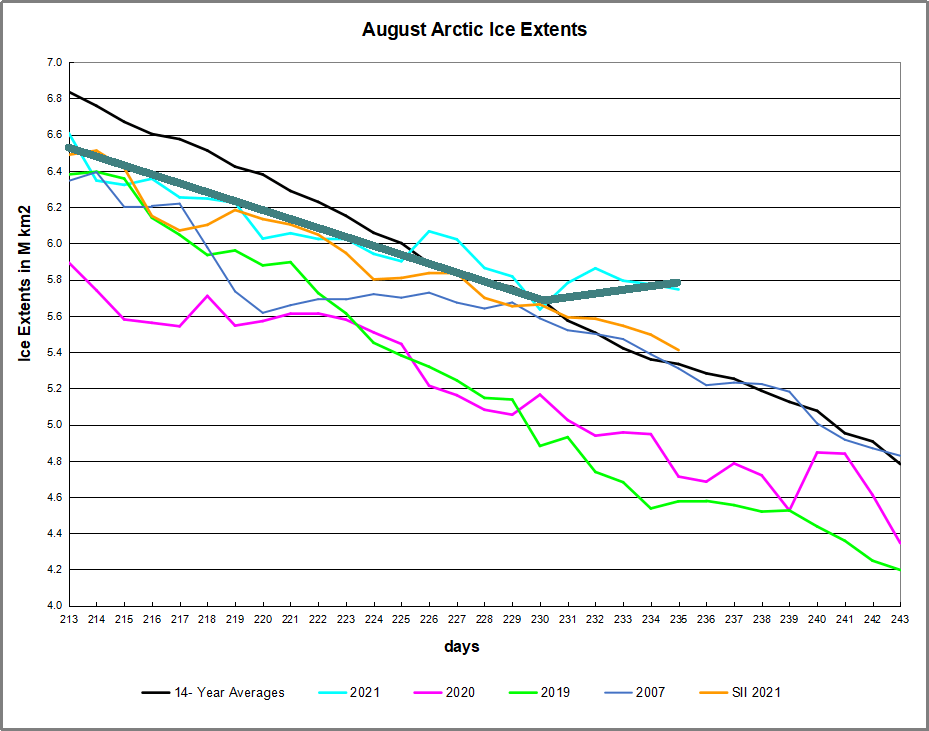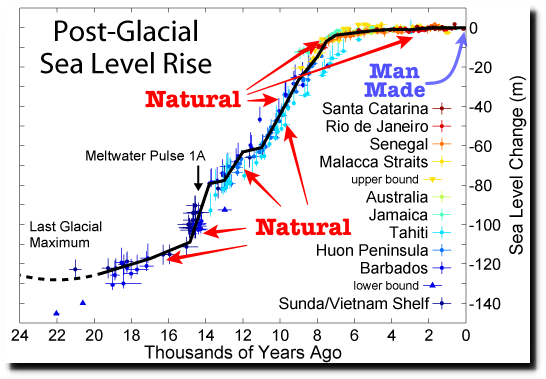
The graph above shows August daily ice extents for 2021 compared to 14 year averages, and some years of note.
The black line shows during this period on average Arctic ice extents decline ~2M km2 from ~6.8M km2 down to ~4.8M km2. The Hockey Stick shape refers to the 2021 cyan MASIE line starting ~227k km2 below average but matching average by day 230, and in the last five days produced a surplus of 414k km2. The Sea Ice Index in orange (SII from NOAA) started with the same deficit and also matched MASIE average day 230, but tracking the downward average since. 2019 and 2020 were well below average at this stage of the summer melt.
Why is this important? All the claims of global climate emergency depend on dangerously higher temperatures, lower sea ice, and rising sea levels. The lack of additional warming is documented in a post Adios, Global Warming
The lack of acceleration in sea levels along coastlines has been discussed also. See USCS Warnings of Coastal Flooding
Also, a longer term perspective is informative:
 The table below shows the distribution of Sea Ice across the Arctic Regions, on average, this year and 2007.
The table below shows the distribution of Sea Ice across the Arctic Regions, on average, this year and 2007.
| Region | 2021235 | Day 235 Average | 2021-Ave. | 2007235 | 2021-2007 |
| (0) Northern_Hemisphere | 5745634 | 5331499 | 414135 | 5309870 | 435765 |
| (1) Beaufort_Sea | 872981 | 605537 | 267444 | 730813 | 142168 |
| (2) Chukchi_Sea | 539676 | 329819 | 209856 | 178493 | 361182 |
| (3) East_Siberian_Sea | 508990 | 445221 | 63769 | 63523 | 445468 |
| (4) Laptev_Sea | 61548 | 205077 | -143529 | 295384 | -233836 |
| (5) Kara_Sea | 136181 | 58898 | 77283 | 155754 | -19573 |
| (6) Barents_Sea | 6047 | 24071 | -18025 | 17998 | -11951 |
| (7) Greenland_Sea | 84815 | 202922 | -118108 | 334622 | -249808 |
| (8) Baffin_Bay_Gulf_of_St._Lawrence | 40877 | 33602 | 7275 | 50303 | -9426 |
| (9) Canadian_Archipelago | 465781 | 354257 | 111524 | 323329 | 142452 |
| (10) Hudson_Bay | 64148 | 35761 | 28387 | 61078 | 3070 |
| (11) Central_Arctic | 2964500 | 3035379 | -70879 | 3097316 | -132816 |
The overall surplus to average is 414k km2, (8%). Note large surpluses of ice in BCE (Beaufort, Chukchi and East Siberian seas). Meanwhile Laptev on the Russian coast melted out early, as has Greenland Sea. Kara and CAA (Canadian Arctic Archipelago) are holding considerable ice. We are about a month away from the annual minimum mid September, but at this point it appears that extents will be greater than the last two years.


Illustration by Eleanor Lutz shows Earth’s seasonal climate changes. If played in full screen, the four corners present views from top, bottom and sides. It is a visual representation of scientific datasets measuring Arctic ice extents.
Reblogged this on Climate Collections.
LikeLike
Reblogged this on Tallbloke's Talkshop and commented:
It will be interesting to see what, if anything much, happens when solar minimum finally fades and the sunspot numbers pick up.
LikeLike
Ron, did you see the article in TheEngineer today about the use of AI to predict arctic ice futures?
If so, is it sensible?
Best regards,
Jack broughton.
LikeLike
Thanks for the heads up, Jack. I haven’t looked into it yet.
LikeLike
I found the press release and see that they are modeling on 40 years of arctic ice satellite data. Since the aim is to predict ice presence 2 months in advance, this resembles weather forecasting using analog years.
The Russian scientists at AARI are convinced the ice extents oscillate on quasi 60- year cycles. The water, wind and weather patterns are complicated and intertwined.
See
https://rclutz.com/2015/12/23/arctic-sea-ice-self-oscillating-system/
https://rclutz.com/2016/03/02/the-great-arctic-ice-exchange/
LikeLike